陈述句(肯定句,否定句)教案讲课稿
肯定句否定句一般疑问句 ppt课件
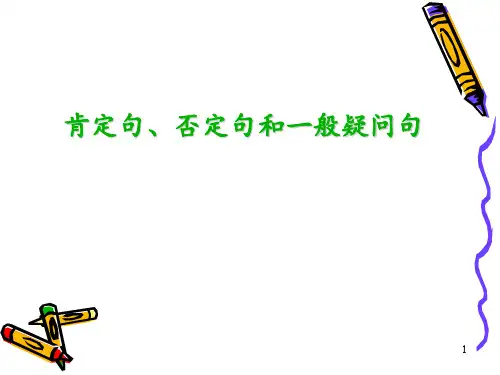
肯定句和一般疑问句之间的转换 My father is a taxi driver. 找出两句话间的联系
→ Is your father a taxi driver? There are some apples on the table. → Are there any apples on the table? As a British, he can play Chinese chess very well. → As a British, can he play Chinese chess very well? Mary will come to China next week. → Will Mary come to China next week?
_______________________________________________________. • 15. He is going to be a teacher in the future. •
_______________________________________________________.
• 9. He ate too much at the party. __________________________________________________ ____.
答案:He didn’t eat too much at the party.
首页 上页 下2页1
• 10. He doesn’t live in London with his uncle. ______________________________________________________. 11.There is some water in the cup.
小学英语语法详解陈述句--肯定句、否定句
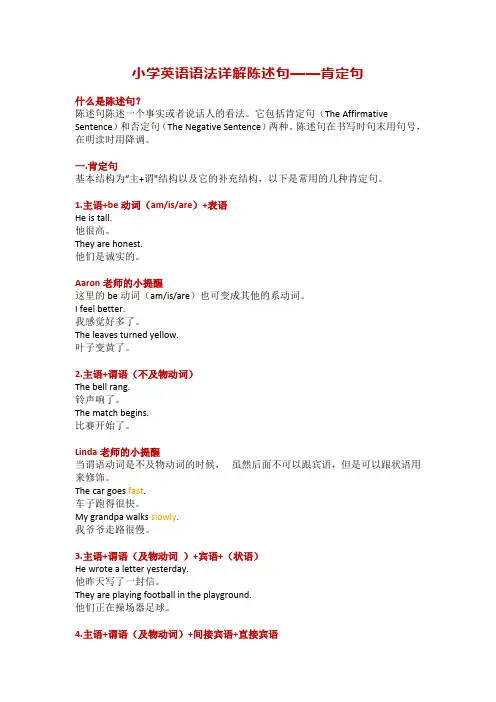
小学英语语法详解陈述句——肯定句什么是陈述句?陈述句陈述一个事实或者说话人的看法。
它包括肯定句(The Affirmative Sentence)和否定句(The Negative Sentence)两种。
陈述句在书写时句末用句号,在明读时用降调。
一.肯定句基本结构为“主+谓"结构以及它的补充结构,以下是常用的几种肯定句。
1.主语+be动词(am/is/are)+表语He is tall.他很高。
They are honest.他们是诚实的。
Aaron老师的小提醒这里的be动词(am/is/are)也可变成其他的系动词。
I feel better.我感觉好多了。
The leaves turned yellow.叶子变黄了。
2.主语+谓语(不及物动词)The bell rang.铃声响了。
The match begins.比赛开始了。
Linda老师的小提醒当谓语动词是不及物动词的时候,虽然后面不可以跟宾语,但是可以跟状语用来修饰。
The car goes fast.车子跑得很快。
My grandpa walks slowly.我爷爷走路很慢。
3.主语+谓语(及物动词)+宾语+(状语)He wrote a letter yesterday.他昨天写了一封信。
They are playing football in the playground.他们正在操场器足球。
4.主语+谓语(及物动词)+间接宾语+直接宾语She psseds me a ball.她传给我一个球。
I give him a hug.我给他一个拥抱。
5.主语+谓语(及物动词)+宾语+宾语补足语I painted it yellow.我把它涂成黄色。
I made her cry.我把她弄哭了。
Aaron老师的小提醒这五种基本句式结构只限于简单句,也就是只包含一个谓语结构,而不包括并列句和复合句。
小学英语语法详解陈述句——否定句什么是陈述句?陈述句陈述一个事实或者说话人的看法。
肯定句和否定句的英文教学教案
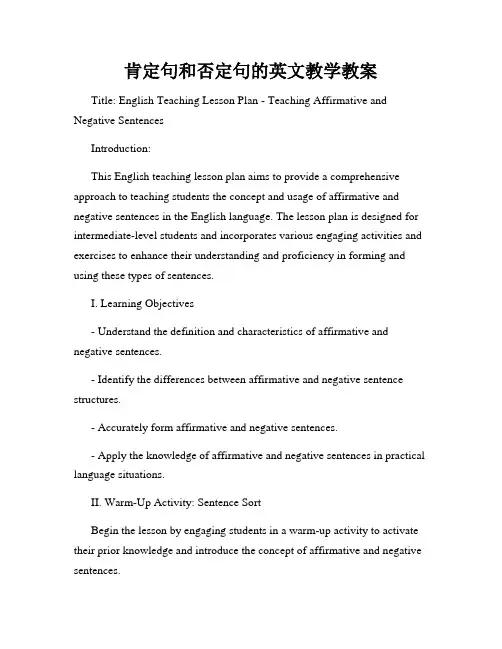
肯定句和否定句的英文教学教案Title: English Teaching Lesson Plan - Teaching Affirmative and Negative SentencesIntroduction:This English teaching lesson plan aims to provide a comprehensive approach to teaching students the concept and usage of affirmative and negative sentences in the English language. The lesson plan is designed for intermediate-level students and incorporates various engaging activities and exercises to enhance their understanding and proficiency in forming and using these types of sentences.I. Learning Objectives- Understand the definition and characteristics of affirmative and negative sentences.- Identify the differences between affirmative and negative sentence structures.- Accurately form affirmative and negative sentences.- Apply the knowledge of affirmative and negative sentences in practical language situations.II. Warm-Up Activity: Sentence SortBegin the lesson by engaging students in a warm-up activity to activate their prior knowledge and introduce the concept of affirmative and negative sentences.- Provide a set of sentence cards, each containing either an affirmative or negative sentence.- Ask students to work individually or in pairs to categorize the sentences into two groups: affirmative and negative.- Discuss the correct categorization as a class, highlighting the key features of each sentence type.III. Explanation and ExamplesProvide a clear explanation of the characteristics and structures of affirmative and negative sentences, along with relevant examples.1. Affirmative Sentences:- Affirmative sentences state something as true or confirm a fact.- Structure: Subject + Verb + Object/Complement.- Examples: "She enjoys playing the piano." "They have completed their homework."2. Negative Sentences:- Negative sentences express the negation or denial of a fact.- Structure: Subject + Auxiliary Verb (e.g., do/does/did) + NOT + Main Verb + Object/Complement.- Examples: "He does not like spicy food." "We did not go to the cinema."IV. Guided Practice: Sentence TransformationIn this activity, students will practice transforming affirmative sentences into negative sentences and vice versa.1. Transforming Affirmative to Negative:- Provide a set of affirmative sentences, either written or projected.- Ask students to work individually to transform each sentence into its corresponding negative form.- Encourage students to pay attention to the correct placement of auxiliary verbs and 'not.'- Discuss the correct answers as a class, clarifying any doubts or difficulties encountered.2. Transforming Negative to Affirmative:- Provide a set of negative sentences.- In pairs or small groups, students should rewrite each sentence into an affirmative form.- Emphasize the need to use appropriate auxiliary verbs and adjust the sentence structure accordingly.- Review the transformed sentences together, ensuring accuracy and understanding.V. Application: Role PlayEngage the students in a role-play activity to practice the usage of affirmative and negative sentences in real-life situations.- Divide the class into pairs, assigning each pair a scenario where they must use appropriate affirmative and negative sentences.- Example scenarios could include ordering food at a restaurant, resolving a conflict, or discussing travel plans.- Encourage students to actively use the target sentence structures in their conversations.- Monitor and provide feedback on their language usage and accuracy.VI. Consolidation: Error CorrectionTo reinforce the learning, students will be presented with a series of sentences containing errors in affirmation and negation.- Provide a handout or project the sentences for the whole class to see.- In pairs or individually, students should identify and correct the errors in each sentence.- Discuss and review the corrections together, explaining the reasoning behind the changes made.VII. Wrap-up: Recap and ReflectionSummarize the key points covered in the lesson, emphasizing the usage and formation of affirmative and negative sentences. Allow students to ask any remaining questions or seek clarification.- Engage in a class discussion or reflective writing activity, where students share their thoughts on the lesson and express their confidence in using affirmative and negative sentences.- Provide constructive feedback and positive reinforcement.VIII. Homework AssignmentAssign homework tasks that involve further practice in forming and using affirmative and negative sentences. This could include completing worksheets, writing short paragraphs, or engaging in online learning platforms.Conclusion:This English teaching lesson plan offers a structured and engaging approach to teaching affirmative and negative sentences. By incorporating various activities, such as sentence sorting, sentence transformation, role-play, and error correction, students will have ample opportunities to develop their understanding and proficiency in using these important sentence types. Through targeted practice and application, students will gain the necessary skills to confidently communicate using affirmative and negative sentences in English.。
最新肯定句否定句句式转换教案提纲2
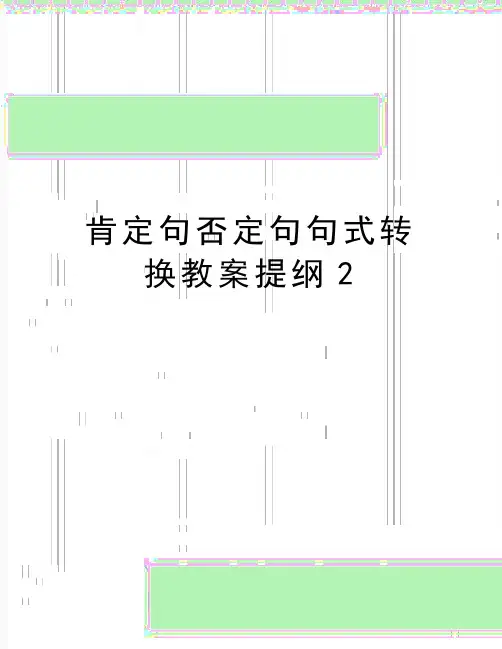
肯定句否定句句式转换教案提纲2.教师:郑老师 学生:_______ 时间:2013年4月____日___________段 一、授课目的与考点分析:1.让学生明白肯定句,否定句的概念;2.让学生初步明白肯定句与否定句转换的规则二、授课的内容:(一)概念讲解1.肯定句:表示肯定的意思, 即不含有否定词“不”。
比如:我是一个学生 I am a student.他去上学 He goes to school.2.否定句:表示否定的意思。
比如:我不是一个男孩。
I am not a boy他不去上学 He does not go to school.(二)具体步骤:首先我们把句子分为两类:含be 与不含be (这里我们为了教学方便,暂时不谈情态动词,只是先针对一般现在时的句子)对于含be 的句子我们只要在be 后直接加not 就行了,Eg:1、I am a student.I am not a student.2、He is a teacher.He is not a teacher.这里注意我们经常把 I am 写成I'm ,is not 写成 isn't ,are not 写成 aren't 等等,所以例1、2 的否定句分别可写为:I ’m not a student.He isn't a teacher.对于不含be 的的句子这时就要考虑加助动词了,这里的助动词为do 与does (三单时用does 。
即对于不含be 的的句子,只需在原句的主语后加相应的助动词再加not 就够了。
Eg 1、I often go to school at sixI do not often go to school at six2、 He often goes to school at sixHe does not often go to school at six温馨提示:A 、 do not = don't does not =doesn'tB 、助动词后加动词原形 简称 动原龙文学校个性化辅导教案提纲ggggggggggggangganggang 纲(三)学生操练:略(四)教师小结三、本次课后作业:肯定句与否定句转换练习题打印卷,请及时上交四、学生对于本次课的评价:○特别满意○满意○一般○差五、教师评定:1、学生上次作业评价:○好○较好○一般○差2、学生本次上课情况评价:○好○较好○一般○差学生签字: ___________ 龙文学校教务处签字:。
最新人教版(部编版)小学语文四年级下册《陈述句》名师教学课件

三、陈述句改反问句的方法
陈述句改反问句的方法
第一步
加上疑问词(怎么、难道) 和语气词(呢、吗) 怎么…… 呢 难道 …… 吗
第二步
有不去“不” 无不加“不”
第三步
变标点。 句号变问号。
陈述句变反问句的例子
难道
不能 吗
例:别人能做到的事情,我们也能做到 。
陈述句变反问句的例子
怎么 呢
能
例:这里的工作那么重要,我不能离开。?
陈述句改反问句的练习。
1、我们是学生,应该遵守学校的纪律。 我们是学生,难道不应该遵守学校的纪律吗?
2、我们应该相信自己的眼睛。
3、功课没做完,不能去看电视。
4、我们不能被困难吓倒。
反问句改陈述句的方法
第一步
去掉疑问词(怎么、难道) 和语气词(呢、吗) 怎么…… 呢 难道 …… 吗
第二步
有不去“不” 无不加“不”
部编版·小学语文四年级下册·第六单元
陈述句与反问句的互换
一、认识陈述句与反问句
陈述句的定义
什么是陈述句
陈述句是陈述一个事实或者说话人的看法的句子。在书写时句末用句号。 它包括肯定形式和否定形式两种。 如:1、今天下雨了。(肯定形式) 2、我不喜欢这幅画。(否定形式)
反问句的定义
什么是反问句
反问句表面看来是疑问的形式,但答案就在问句之中, 也就是明知故问。反问句比一般的陈述句语气更强,更能 引起人们的思考。反问句一般含有“难道 …… 吗”“怎 么 ……呢”等表示反问语气的词。它的句末一般用问号。 如“难道我会不知道?”
二、遵循的原则
两种句式的互换应该遵循“在不改变句子 原来的意思”的情况下。
第三步
变标点。 问号变句号
一个教案搞定否定和疑问,找我
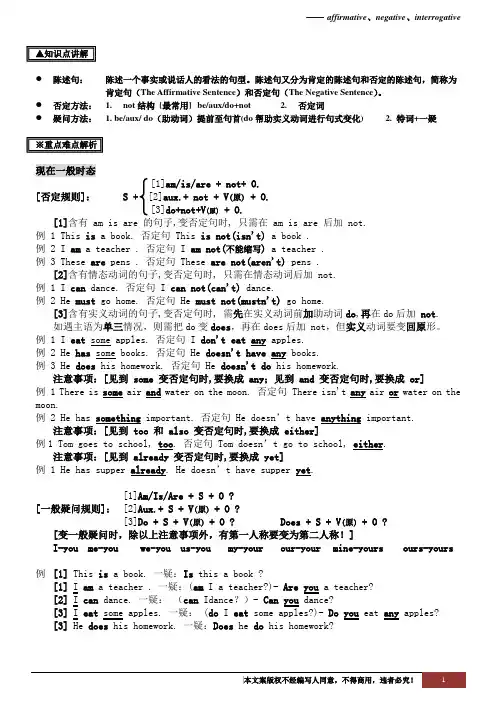
▲知识点讲解●陈述句:陈述一个事实或说话人的看法的句型。
陈述句又分为肯定的陈述句和否定的陈述句,简称为肯定句(The Affirmative Sentence)和否定句(The Negative Sentence)。
●否定方法: 1. not结构[最常用] be/aux/do+not 2. 否定词●疑问方法: 1. be/aux/ do(助动词)提前至句首(do帮助实义动词进行句式变化) 2. 特词+一疑※重点难点解析现在一般时态[1]am/is/are + not+ O.[否定规则]:S + [2]aux.+ not + V(原) + O.[3]do+not+V(原) + O.[1]含有 am is are 的句子,变否定句时, 只需在 am is are 后加 not.例 1 This is a book. 否定句 This is not(isn't) a book .例 2 I am a teacher . 否定句 I am not(不能缩写) a teacher .例 3 These are pens . 否定句 These are not(aren't) pens .[2]含有情态动词的句子,变否定句时, 只需在情态动词后加 not.例 1 I can dance. 否定句 I can not(can't) dance.例 2 He must go home. 否定句 He must not(mustn't) go home.[3]含有实义动词的句子,变否定句时, 需先在实义动词前加助动词do,再在do后加not.如遇主语为单三情况,则需把do变does,再在does后加 not,但实义动词要变回原形。
例 1 I eat some apples. 否定句 I don't eat any apples.例 2 He has some books. 否定句 He doesn't have any books.例 3 He does his homework. 否定句 He doesn't do his homework.注意事项:[见到some 变否定句时,要换成 any;见到and 变否定句时,要换成 or]例 1 There is some air and water on the moon. 否定句 There isn't any air or water on the moon.例 2 He has something important. 否定句 He doesn’t have anything important.注意事项:[见到too 和 also 变否定句时,要换成 either]例1 Tom goes to school, too. 否定句Tom doesn’t go to school, either.注意事项:[见到 already 变否定句时,要换成 yet]例 1 He has supper already. He does n’t ha ve supper yet.[1]Am/Is/Are + S + O ?[一般疑问规则]:[2]Aux.+ S + V(原) + O ?[3]Do + S + V(原) + O ? Does + S + V(原) + O ?[变一般疑问时,除以上注意事项外,有第一人称要变为第二人称!]I-you me-you we-you us-you my-your our-your mine-yours ours-yours例[1] This is a book. 一疑:Is this a book ?[1] I am a teacher . 一疑:(am I a teacher?)- Are you a teacher?[2] I can dance. 一疑:(can Idance?)- Can you dance?[3] I eat some apples. 一疑: (do I eat Do you eat any apples?一疑:Does he do his homework?[1]was/were + not+ O.[否定规则]:S + [2]aux.(过去式)+ not + V(原) + O.[3]did+not+V(原) + O.[1]含有 was were 的句子,变否定句时, 只需在 was were 后加例 1 This was a book. 否定: This was not(wasn't) a book .例 2 I was a teacher . 否定: I was not(wasn't) a teacher .例 3 These were pens . 否定: These were not(weren't) pens .[2]含有情态动词的句子,变否定句时, 只需在情态动词后加例 1 I could dance. 否定: I could not(couldn't) dance.例 2 He must go home. 否定: He must not(mustn't) go home.[3]含有实义动词的句子,变否定句时, 需先在实义动词前加助动词did,再在did后加除了[现在一般时态],其它时态都没有单三情况例 some apples. any apples.例 2 He had some books. 否定: He didn't have any books.例 3 He did his homework. 否定: He didn't do his homework.[见到some 变否定句时,要换成 any;见到and 变否定句时,要换成 or]例 1 There was some air and water on the moon. 否定: There wasn't any air or water on the moon.例 2 He had something important. 否定: He didn’t have anything important.[见到变否定句时,要换成 either]例1 Tom went to school, too. 否定: Tom did n’t go to school, either.[见到 already 要换成 yet]例 1 He had supper already.否定:He did n’t ha ve supper yet.[1]Was/Were + S + O ?[一般疑问规则]:[2]Aux.(过去式)+ S + V(原) + O ?[3]Did + S + V(原) + O ?[变一般疑问时,除以上注意事项外,有第一人称要变为第二人称!] I-you me-you we-you us-you my-your our-your mine-yours ours-yours例[1] This was a book. 一疑:Was this a book ?[1] I was a teacher . 一疑:(was I a teacher?)- Were you a teacher?[2] I could dance. 一疑:(could Idance?)- Could you dance?[3] I ate some apples. 一疑: (did I eat some apples?)- Did you eat any apples?[3] He 一疑:Did he do his homework?[1] be动词没有进行状态[否定规则]:S + [2] aux. 动词没有进行状态[3] am/is/are + not + Ving + O.[1]类没有进行状态[2]类没有进行状态[3]类动词的句子,变否定句时, 需在助动词be后加除了[现在一般时态],其它时态都没有单三情况例 some apples. any apples.例 3 He is doing his homework. 否定: He is not doing his homework.[见到some 变否定句时,要换成 any;见到and 变否定句时,要换成 or]例 I am eating some apples. 否定: I am not eating any apples.[见到too 和 also 变否定句时,要换成 either]例1 Tom is going to school too. 否定: Tom is n’t go ing to school either.[见到 already yet]进行状态不可能出现already(已经)和yet(仍然)两个时间词。
句子教学一
小学语文低年级句子教学一
学生姓名 考核内容 陈述句(肯定句与否定句)、反问句 难度系数 中 家长签名 授课老师 范老师
授课时段 剩余课时 成绩 一.陈述句的概念:是陈述一个事实或者说话人的看法,陈述句分为肯定句和否定句。 1.肯定句的概念:对事物做出肯定判断的句子叫做肯定句.例如:他是一名好学生。 2.否定句的概念:对事物做出否定判断的句子叫做否定句。例如:他不是一名好学生 3.肯定句与否定句之间的转化原则:(1)不能改变原意。(2)肯定句改为否定句时,要加两个否定词,否则就改变了原意。例如:“我想去公园”。改为否定句,要加两个否定词,“我不是不想去公园”(没有改变原意),如果只加一个否定词,则变为“我不想去公园”(改变了原意)。 二.反问句的概念:反问句就是用疑问的句式,表达肯定的观点。反问句表面看来是疑问的形式,但实际上表达的是肯定的意思,答案就在问句之中。反问的形式比一般的陈述句语气更强,更能引起人们的思考。例如:难道你就不想去吗?。基本结构:反问语气词+主语+肯定词/否定词+宾语+疑问助词+问号。 1.陈述句改反问句:(1)将肯定句中的肯定词(是、能、会等)改为否定词(不是、不能、不会等)。(2)将否定句中的否定词(不是、不能、不会等)改为肯定词(是、能、会等)。 (3)在肯定词或否定词前面加上“怎、怎么、难道、岂”等反问语气词。(4)句尾加上疑问助词“呢、吗”等,句末的句号改为问号。例如:雷锋叔叔是我们学习的榜样。在改反问句时,将肯定词“是”改为否定词“不是”,在句首加上“难道”,句尾加上“吗”,句末的句号改为问号。这样,改成的反问句是:难道雷锋叔叔不是我们学习的榜样吗? 2.反问句改陈述句:(1)将反问句中的肯定词改为否定词,或将否定词改为肯定词。 (2)将反问句中的反问语气词(怎、怎么、难道等)去掉。 (3)将句末的疑问助词(呢、吗等)去掉,问号改为句号。 例如:我们怎能言而无信呢?在改为陈述句时,将“能”改为“不能”,去掉“怎”,将“呢”去掉,问号改为句号。所改成的陈述句是:我们不能言而无信
肯定句和否定句PPT课件
2021/3/9
授课:XXX
3
試在以下空格填上適當的答案。
肯定句:
定義:_______________________
例句:_______________________
否定句:
定義:_______________________
例句:_______________________
雙重否定句:
定義:_______________________
2021/3/9
授课:XXX
5
肯定句:
•對事物作出正面的肯定判斷的句
子。所謂肯定,即對事物的存在和
真實性予以正面的承認,或經過判
斷表示贊成,或對問題作出肯定的
明確的答覆。如「小張的個子矮。」
「今天的天氣太好了!」這種使用
肯定語氣詞語的陳述句或感歎句,
都屬於肯定句。 2021/Biblioteka /9授课:XXX6
否定句:
• 我唱得不太動人…… • 費高是全球最高身價的足球員。 • 眼見很多學生上課時打瞌睡,梁老師不得
不承認自己教學法比較沉悶。 • 青蟲不易捕,黃口無飽期。 • 沒有一個人不認為米高.佐敦是一個偉大
的籃球員。
2021/3/9
授课:XXX
13
試辨析以下句子,看屬於哪一句類
• 我唱得不太動人…… 否定句 • 費高是全球最高身價的足球員。肯定句 • 眼見很多學生上課時打瞌睡,梁老師不得
例句:_______________________
2021/3/9
授课:XXX
4
肯定句: 定義:表示肯定意思的句子。 例句:他是一個好學生。 否定句: 定義:表示否定意思的句子。 例句:他不是一個好學生。 雙重否定句: 定義:用兩個否定詞表示肯定語氣的句子。 例句:老師不得不承認他是一個好學生。
《句子的分类》教学PPT课件
含有一个否定词的否定句叫一般否
定句。
如:我不能告诉老师。 否定的意思
二、双重否定句
含有两个否定词的否定句叫双重否
定句。
如:我不能不告诉老师。
肯定的意思
2021
5
问句
用来向别人提出问题的句子叫问句。 问句的句尾语调上升,常带有疑问助 词“呢、吗、呀、么 ‥‥‥”句末用问号。
例如:1、这本书是你的吗? 2、你吃过午饭了吗? 3、他在院子里做什么呢?
2、有几个虫子怕什么! 3、做错了是不应该道歉吗?
2021
10
设问句
设问句也是一种无疑而问的问句, 不需要对方回答。它总是自己问自己答。 目的是为了设置悬念,引起读者或听众 的思考或注意。
如:1、有困难就不做了吗?当然不是! 2、科学家说的话都对吗?也不一定。 3、对于学生来说,最重要的事是什么 呢?是学习。
疑问句反问句设问句一般疑问句选择疑问句是非疑问句问句的分类8疑问句疑问句是有疑而问的问句提问者不知道答案是为寻找答案而提的问题需要对方回答
句子的分类
根据语气和用途的不同,我们 可以把句子分为以下四种:
1、陈述句 2、疑问句 3、感叹句 4、祈使句
2021
1
陈述句
用来陈述或说明一件事句子叫陈述 句。
例如:请把书递给我。 请求 不许随地吐痰﹗ 禁止 把枪放下,举起手来﹗ 命令 不要整天玩手机! 劝阻
2021
13
双重否定句: 表达肯定的意思
含否定词“不”、 “没有”······
比肯定句更强烈
2021
3
肯意思的句子叫肯定句。 如:1、她是我的妈妈。
2、我可以去。
二、否定句
含有否定词的句子叫否定句。
肯定句与否定句和双重否定句的转换课件
出现宾语就找宾语。)
例:她很漂亮。
小红是个女生。
丑陋
男生
2、加否定词。(一般情况下加在谓语动词前,如
果出现“很、非常、常常、都”
等表示程度的副词时把它去掉。)
例:她很漂亮。 小红是个女生。
她不丑陋。 小红不是个男生
第四页,本课件共有9页
肯定句改为双重否定句的方法:
三种情况:
1、如果肯定句中出现“一定、必须、肯定”之类表示肯定的词语,那么把他们改为 “非……不可”、“不能不”、“不得不”等双重否定词。
关于肯定句与否定句 和双重否定句的转换
第一页,本课件共有9页
陈述句:用于告诉别人一件事或一个道理,表 示陈述语气的句子,一般语调平和,句尾用句 号。
例:放假我去奶奶家。
肯定句:用来说明或肯定某一事物(或事实)的句子。
例:他是一位医生。
否定句:用来否定某一事实的句子。
例:他的字写得不好。
双重否定句:一句话中有两个否定词,用否定加否定的形式来表达 肯定的语意。
把下面的句子改为否定句
1、我们要遵守交通规则。 我们不能违反交通规则。
2、地球上的自然资源是有限的。
3、地教球室上十的分自热然闹资。源不是无限的。 教室不安静。
4、我们应该保护环境。 5、他我们是不个应爱该撒破谎坏的环孩境子。
他是个不诚实的孩子。
第八页,本课件共有9页
第九页,本课件共有9页
例:我们必须遵守国家的法律。
我们不能不遵守国家的法律。
2、如果肯定句中出现“人们都、大家、全部”等表示复数的词语,则把他改为 “没有一个人不”、“没有……不”、“无不”等词语。
例:人们都说他是一个好人。
没有一个人不说他是一个好人。
- 1、下载文档前请自行甄别文档内容的完整性,平台不提供额外的编辑、内容补充、找答案等附加服务。
- 2、"仅部分预览"的文档,不可在线预览部分如存在完整性等问题,可反馈申请退款(可完整预览的文档不适用该条件!)。
- 3、如文档侵犯您的权益,请联系客服反馈,我们会尽快为您处理(人工客服工作时间:9:00-18:30)。
精品文档
精品文档
陈述句
一、 陈述句的概念
陈述句是用于陈述事实和观点的句子。陈述句包括肯定结构和否定结构,句末用句号。如:
This is a desk. (肯定结构)
He can sing and dance. (肯定结构)
He doesn’t have a computer. (否定结构)
There aren’t any pictures. (否定结构)
二、 肯定句变否定句的基本方法
1. be动词的否定式
be 动词根据不同的人称和时态有不同的形式,在一般现在时中是am , is , are可用作联系动
词,构成否定式时,一律在其后面加否定词not.
He is reading. --- He is not reading. They are from China. --- They are not from China.
2. 情态动词的否定式
情态动词的否定式是在其后面直接加not. 如:
I can swim. --- I can’t swim. He can dance. --- He can’t dance.
You should go to school at seven. --- You shouldn’t go to school at seven.
3. 实义动词的否定句
实义动词变否定句时,要借助助动词do , does,在一般现在时中用do或者does其句子结构
为:主语+ don’t / doesn’t + 动词原形+其它
例如:
I like pop music. --- I don’t like pop music.
He likes running. --- He doesn’t like running.
She does her homework at home. --- She doesn’t do her homework at home.
典型例题:
1. My sister ______ moon cakes with eggs in them.
A. don’t like B. doesn’t like C. doesn’t likes D. doesn’t liking
2. He often does his homework at home. 变为否定句
_______________________________________________________________
3 . He doesn’t goes to the zoo every Sunday.(改错题) ( )_________
A B C D
4. Does Li Lei likes sports? (判断正误)( )
开心练习:
精品文档
精品文档
一、 将下列句子变为否定句,每空一词。
1. This is a desk.
This ________ a desk.
2. Grandpa tells stories to us every evening.
Grandpa ________ ________ stories to us every evening.
3. He can draw pictures.
He _______ draw pictures.
4. He has a nice watch.
He _______ _______ a nice watch.
5. They do a lot of homework at school.
They ________ ________ a lot of homework at school.
6. You must play football here.
You ________ play football here.
7. They are having an English class.
They _________ _________ an English class.
8. Peter goes to the zoo once a year.
Peter _________ _________ to the zoo once a year.
开心突破:
二、 下面各句四处划线部分有一处是错误的,请指出并改正。
1. He doesn’t the homework every day. ( )
A B C D
2. He doesn’t have some rice for supper. ( )
A B C D
3. This coat are red. That coat is blue. ( )
A B C D
4. He don’t go to school yesterday. ( )
A B C D
三、连词成句。
1. playing , like , I , football
_______________________________________________________
2.aren’t , any , wall , the , pictures , there , on
_______________________________________________________
3. waiting , bus , for , the , we , are
_______________________________________________________
4. much , the , how , shirt , is
_______________________________________________________
